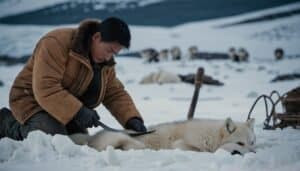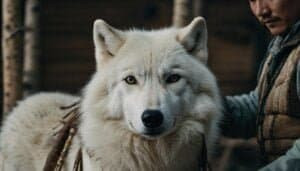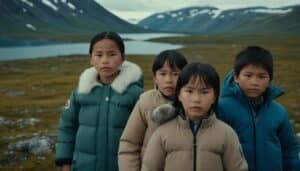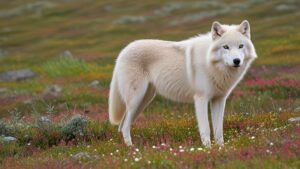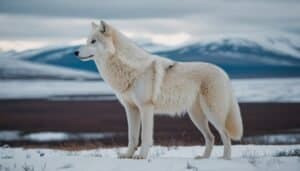Introduction
Traditional narratives play a significant role in teaching children about the world around them, especially within indigenous communities. One such example is the use of Arctic wolf behaviors in stories to impart lessons about nature, survival, and community values
These tales often highlight the wolves’ pack dynamics, survival skills, and cultural significance, offering children valuable insights into cooperation, respect for nature, and resilience
This article will explore the key behaviors of Arctic wolves depicted in traditional stories, the lessons they teach, and some popular tales that feature these majestic creatures
Key Arctic Wolf Behaviors in Traditional Narratives
Arctic wolves, with their unique behaviors and adaptations, have been integral to traditional narratives, especially among indigenous Arctic communities
These stories serve as educational tools, helping to convey important lessons to children about their environment and culture. By understanding how Arctic wolf behaviors are depicted in these narratives, we can appreciate the richness of this storytelling tradition
Depiction of Pack Dynamics
The pack dynamics of Arctic wolves are central to many traditional stories. These tales often highlight the importance of teamwork and social structure within the pack. For example, in Inuit stories, the wolves’ cooperative hunting strategies are used to teach children the value of working together towards a common goal
The alpha wolf, as a leader, is depicted as both strong and wise, demonstrating the qualities of good leadership and the importance of each member’s role within the group
One story might describe how the alpha wolf leads the pack in a coordinated effort to hunt caribou, emphasizing communication and coordination. This narrative helps children understand the necessity of cooperation and the roles individuals play in achieving success
The pack’s hierarchy also teaches children about respect for authority and the responsibilities that come with leadership positions
Emphasis on Survival Skills
Arctic wolves are adept at surviving in one of the harshest climates on Earth, and their survival skills are often highlighted in traditional narratives
These stories convey essential lessons about resilience and adaptation. For instance, a story might depict a wolf enduring a severe winter, finding food, and protecting its pack. This teaches children about perseverance and the importance of adapting to changing conditions
Survival tales often include elements of resourcefulness, such as how wolves use their keen sense of smell to locate prey buried under snow or how they communicate through howls to coordinate their movements over vast distances. By illustrating these behaviors, the stories not only provide practical knowledge about the natural world but also inspire children to be resourceful and persistent in the face of challenges
Hunting and Feeding Practices
Hunting is a critical aspect of Arctic wolf behavior, and traditional narratives often focus on their hunting techniques and strategies
These stories serve as a means to impart knowledge about the natural food chain and the circle of life. By observing the wolves’ hunting practices, children learn about the balance of nature and the interdependence of species
A common story might describe a wolf tracking its prey for miles, teaching patience and determination. The wolves’ ability to bring down larger prey through teamwork is another common theme, reinforcing the idea that working together can overcome significant challenges
Additionally, stories about feeding practices, such as how the pack shares food, teach children about the importance of sharing and looking after one another
Teaching Cooperation Through Wolf Pack Dynamics
Traditional narratives frequently use the cooperative nature of wolf packs to teach children about the importance of working together
The intricate social structures and teamwork within a wolf pack serve as powerful metaphors for human relationships and community dynamics. By examining these stories, we can gain insights into how cooperation is emphasized and valued
Importance of Teamwork in Stories
Many traditional stories emphasize the importance of teamwork through the actions and behaviors of wolf packs
These narratives often illustrate how wolves rely on each other for hunting, protection, and survival. For example, a story might depict a lone wolf struggling to find food and shelter, only to thrive once it rejoins its pack. This highlights the concept that individuals are stronger and more successful when they work together
Such stories teach children that cooperation and mutual support are essential for overcoming obstacles. They learn that just as wolves must work together to hunt and protect each other from threats, humans too must collaborate and support one another to achieve common goals and ensure the well-being of their community
Lessons on Leadership and Roles
Within wolf packs, each member has a specific role, and traditional stories often use these roles to teach children about leadership and the importance of fulfilling one’s responsibilities
The alpha wolf, typically depicted as the leader, is responsible for making crucial decisions and guiding the pack. Stories focusing on the alpha’s leadership qualities teach children about the importance of wisdom, strength, and responsibility in leadership
Other roles, such as the beta wolves and the omega, are also highlighted in these narratives. Beta wolves are often portrayed as second-in-command, helping to enforce the alpha’s decisions and maintain order
The omega, while often seen as the lowest-ranking member, plays a crucial role in diffusing tension and maintaining pack harmony. By showcasing these roles, stories convey the message that every individual has a valuable part to play, and that effective teamwork relies on everyone contributing their unique strengths
Conflict Resolution within the Pack
Conflict is a natural part of any social group, and wolf packs are no exception. Traditional narratives often incorporate stories of conflict within the pack to teach children about conflict resolution and the importance of maintaining harmony
These stories might depict disagreements between wolves over food or hierarchy, followed by the resolution of these conflicts through communication and compromise
For instance, a story could describe a dispute between two wolves vying for a higher rank, which is ultimately resolved through a non-lethal display of dominance or submission, reinforcing the pack’s social structure. This teaches children that conflicts can be resolved peacefully and that maintaining relationships is more important than winning an argument. It also highlights the value of communication and understanding in resolving disputes
Survival Skills Highlighted in Stories
The harsh Arctic environment poses significant challenges for its inhabitants, and Arctic wolves are particularly adept at navigating these difficulties
Traditional narratives often highlight these survival skills to impart valuable lessons about resilience, adaptation, and resourcefulness to children. By focusing on how wolves overcome the extreme conditions of their habitat, these stories offer practical and moral guidance
Navigating Harsh Arctic Conditions
Arctic wolves thrive in one of the most unforgiving environments on Earth. Stories often depict wolves navigating through blizzards, enduring long periods of darkness, and traversing icy terrain. These narratives illustrate the wolves’ incredible stamina and navigation skills, teaching children the importance of perseverance and determination
A common story might involve a wolf pack traveling great distances in search of food, overcoming obstacles such as frozen rivers and snow-covered landscapes
By following the wolves’ journey, children learn that challenges are a part of life and that persistence is key to overcoming them. The wolves’ ability to stay on course despite harsh conditions serves as a metaphor for staying focused on goals despite obstacles
Adaptations to Extreme Weather
Arctic wolves have evolved several adaptations that enable them to survive in extreme weather, and these adaptations are often highlighted in traditional stories. These tales might describe how wolves use their thick fur to stay warm or how they dig dens in the snow to protect themselves from the cold
For example, a story could focus on a mother wolf creating a den for her pups, teaching children about the importance of preparation and protection in harsh environments
Another narrative might describe wolves using their keen sense of smell to find prey buried under snow, illustrating the importance of utilizing one’s strengths and resources to survive. These adaptations serve as practical lessons in resilience and ingenuity
Strategies for Finding Food
Finding food in the Arctic is a constant challenge, and the hunting strategies of Arctic wolves are frequently featured in traditional narratives. These stories teach children about the importance of planning, patience, and teamwork. By depicting wolves tracking and hunting their prey, these tales convey crucial survival skills
A story might describe a wolf pack coordinating a hunt for caribou, showing how they use stealth, strategy, and cooperation to catch their prey
The wolves’ ability to endure long hunts and work together to bring down larger animals teaches children the value of patience and collaboration. Another common theme is the sharing of food within the pack, emphasizing the importance of taking care of one another and ensuring that everyone has enough to eat
Through these narratives, children learn not only about the practical aspects of survival in a harsh environment but also about the broader themes of cooperation, resilience, and resourcefulness. The wolves’ behaviors provide a framework for understanding how to face challenges, support each other, and make the most of available resources
Cultural Values Conveyed Through Wolf Behaviors
Traditional narratives about Arctic wolves do more than just depict their natural behaviors; they also serve as vehicles for conveying deep cultural values
These stories are rich with lessons about respect for nature, the importance of family and community, and the qualities of resilience and strength. By examining these cultural values, we can gain a deeper understanding of the wisdom embedded in these narratives
Respect for Nature and Wildlife
One of the most prominent themes in traditional stories featuring Arctic wolves is the deep respect for nature and wildlife
These narratives often portray wolves as integral parts of the natural world, living in harmony with their environment. For example, stories may depict wolves as careful stewards of their habitat, taking only what they need and leaving the ecosystem balanced
A common tale might involve a wolf teaching its pups about the importance of respecting other animals and the land they live on. Such stories instill a sense of reverence for the natural world in children, emphasizing that humans, like wolves, are part of a larger ecosystem and must act responsibly to maintain its health and balance
Importance of Family and Community
The social structure of wolf packs, with their strong emphasis on family and community, is often used to convey the importance of these values in human society
Traditional stories highlight the close bonds between pack members and the care they show for each other. These tales teach children about the significance of family support and the strength that comes from being part of a close-knit community
For instance, a story might focus on a young wolf learning from its elders, showing the importance of intergenerational relationships and the transfer of knowledge. Another narrative might describe how the pack comes together to care for injured or sick members, demonstrating the values of compassion and mutual support. By highlighting these aspects, the stories encourage children to value their own families and communities
Lessons on Resilience and Strength
Arctic wolves are symbols of resilience and strength, qualities that are frequently emphasized in traditional narratives. These stories often depict wolves overcoming adversity and thriving despite harsh conditions, serving as powerful metaphors for human perseverance and inner strength
A story might tell of a lone wolf surviving a particularly brutal winter, illustrating the themes of endurance and resilience
Another might describe a pack defending its territory from threats, showcasing bravery and strength in the face of danger. These narratives teach children that resilience and strength are essential qualities for overcoming challenges and achieving success
Through the behaviors of Arctic wolves, these traditional stories provide valuable lessons that are deeply rooted in cultural values. They teach children to respect the natural world, value their families and communities, and develop resilience and strength. By embedding these values in engaging narratives, these stories ensure that important cultural wisdom is passed down to future generations
Popular Traditional Stories Featuring Arctic Wolves
Traditional stories featuring Arctic wolves are rich with cultural heritage and wisdom, offering insights into the lives and values of the people who tell them
These narratives are often passed down through generations, preserving important lessons and fostering a deep connection with the natural world. Here are some popular traditional stories that highlight the roles of Arctic wolves
“The Wolf and the Northern Lights”
“The Wolf and the Northern Lights” is a popular story that explains the origin of the Aurora Borealis through the adventures of a brave Arctic wolf. In this tale, a young wolf ventures into the sky to chase the spirits of its ancestors, creating the beautiful lights as it dances among the stars
This story not only provides a magical explanation for a natural phenomenon but also teaches children about bravery, curiosity, and the connection between life and the spirit world
The wolf’s journey is filled with challenges that it overcomes through courage and determination, inspiring children to face their own challenges with similar qualities. The story also emphasizes the importance of remembering and honoring one’s ancestors, fostering a sense of continuity and respect for the past
“The Brave Wolf Pup”
“The Brave Wolf Pup” is a tale about a young wolf who learns the values of courage and responsibility
The story follows the pup as it grows and faces various trials, such as protecting its pack from predators and navigating harsh weather conditions. Through these experiences, the pup learns important life lessons and eventually becomes a respected leader within the pack
This story is often told to teach children about the process of growing up and the importance of taking on responsibilities. It highlights the qualities of bravery, leadership, and the importance of learning from one’s experiences. The wolf pup’s journey serves as a metaphor for the journey from childhood to adulthood, encouraging children to embrace their own growth and development
“The Guardian of the Arctic”
In “The Guardian of the Arctic,” an Arctic wolf is portrayed as a protector of the land and its inhabitants
This story describes how the wolf watches over the Arctic environment, ensuring that the balance of nature is maintained. The wolf intervenes to protect other animals and the land from harm, demonstrating wisdom, strength, and a deep connection to the natural world
This narrative is often used to teach children about the role of guardianship and the importance of protecting the environment. It emphasizes the idea that everyone has a responsibility to care for their surroundings and to act as stewards of the Earth. The wolf’s actions in the story serve as a model for children, encouraging them to develop a sense of environmental responsibility and stewardship
These traditional stories featuring Arctic wolves are more than just entertaining tales; they are educational tools that convey important cultural values and lessons
By engaging with these narratives, children learn about bravery, responsibility, leadership, and respect for the natural world. The enduring popularity of these stories ensures that these lessons continue to be passed down through generations, preserving the cultural heritage and wisdom of the communities that tell them
Conclusion
Arctic wolves play a significant role in traditional narratives, serving as powerful symbols of nature, resilience, and community. These stories are integral to the cultural heritage of many indigenous Arctic communities, offering valuable lessons to children about the natural world and human values
Through the depiction of wolf pack dynamics, survival skills, and hunting practices, these narratives teach important concepts such as cooperation, leadership, and resourcefulness. Moreover, they convey deep cultural values, emphasizing respect for nature, the importance of family and community, and the qualities of resilience and strength
By exploring popular traditional stories, we can appreciate the richness of these narratives and the wisdom they impart. The enduring legacy of these tales ensures that the lessons and values they embody continue to be passed down through generations, fostering a deep connection between people and the natural world


